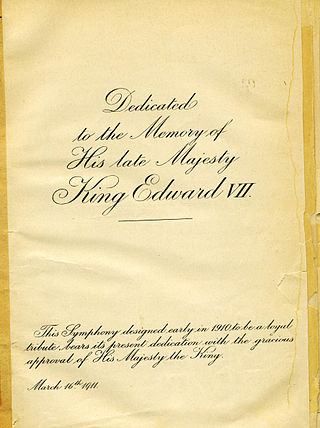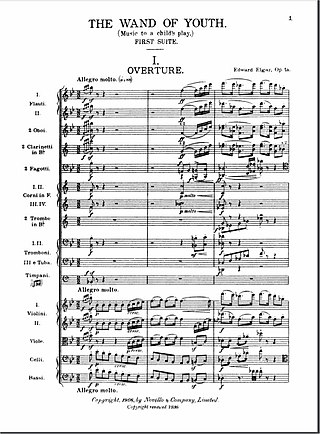The Pomp and Circumstance Marches, Op. 39, are a series of five marches for orchestra composed by Sir Edward Elgar. The first four were published between 1901 and 1907, when Elgar was in his forties; the fifth was published in 1930, a few years before his death; and a sixth, compiled posthumously from sketches, was published in 1956 and in 2005–2006. They include some of Elgar's best-known compositions.

Sir Edward Elgar's Symphony No. 2 in E♭ major, Op. 63, was completed on 28 February 1911 and was premiered at the London Musical Festival at the Queen's Hall by the Queen's Hall Orchestra on 24 May 1911 with the composer conducting. The work, which Elgar called "the passionate pilgrimage of the soul", was his last completed symphony; the composition of his Symphony No. 3, begun in 1933, was cut short by his death in 1934.

Sir Edward Elgar's Symphony No. 1 in A♭ major, Op. 55 is one of his two completed symphonies. The first performance was given by the Hallé Orchestra conducted by Hans Richter in Manchester, England, on 3 December 1908. It was widely known that Elgar had been planning a symphony for more than ten years, and the announcement that he had finally completed it aroused enormous interest. The critical reception was enthusiastic, and the public response unprecedented. The symphony achieved what The Musical Times described as "immediate and phenomenal success", with a hundred performances in Britain, continental Europe and America within just over a year of its première.

Crown Imperial is an orchestral march by William Walton, commissioned for the coronation of King George VI in Westminster Abbey in 1937. It is in the Pomp and Circumstance tradition, with a brisk opening contrasting with a broad middle section, leading to a resounding conclusion. The work has been heard at subsequent state occasions in the Abbey: the coronation of Queen Elizabeth II in 1953, the wedding of Prince William in 2011 and the coronation of King Charles III in 2023. It has been recorded in its original orchestral form and in arrangements for organ, military band and brass band.

In the South (Alassio), Op. 50, is a concert overture composed by Edward Elgar during a family holiday in Italy in the winter of 1903 to 1904. He was working on a symphony, but the local atmosphere inspired him instead to write what some have seen as a tone poem, with an Italian flavour. At about 20 minutes' duration it was the composer's longest sustained orchestral piece to that time.

The Wand of Youth Suites No. 1 and No. 2 are works for orchestra by Edward Elgar, first performed in 1907 and 1908 respectively. The titles Elgar gave them were, in full: The Wand of Youth First Suite, Op. 1a (1869–1907) and The Wand of Youth Second Suite,. The music was drawn from material written by the composer in his youth and orchestrated forty years or so later.

The Nursery Suite is one of the last compositions by Edward Elgar. Like Elgar's The Wand of Youth suites, it makes use of sketches from the composer's childhood.
Dream Children, Op 43 is a musical work for small orchestra by Edward Elgar. There are two movements:
Froissart, Op. 19, is a concert overture by Edward Elgar, inspired by the 14th-century Chronicles of Jean Froissart. Elgar was first attracted to the Chronicles after finding mention of them in Walter Scott's Old Mortality.

Ebenezer Prout was an English musical theorist, writer, music teacher and composer, whose instruction, afterwards embodied in a series of standard works still used today, underpinned the work of many British classical musicians of succeeding generations.
"Follow the Colours" is a marching song written by the English composer Edward Elgar in 1907, with words by Capt. William de Courcy Stretton. The song is for male voice solo with an optional male voice chorus, accompanied by piano, orchestra or military band.

Salut d'Amour (Liebesgruß), Op. 12, is a musical work composed by Edward Elgar in 1888, originally written for violin and piano.
Chanson de Nuit, Op. 15, No. 1, is a musical work composed by Edward Elgar for violin and piano, and later orchestrated by the composer. Its first publication was in 1897, though it is considered that it was almost certainly written in 1889 or 1890.

Chanson de Matin, Op. 15, No. 2, is a musical work composed by Edward Elgar for violin and piano, and later orchestrated by the composer. Its first publication was in 1899, though it is thought that it was almost certainly written in 1889 or 1890.

Queen Alexandra's Memorial Ode is an ode "So many true Princesses who have gone" written by John Masefield and set to music for choir and orchestra by Sir Edward Elgar for the occasion of the unveiling of Sir Alfred Gilbert's memorial to Queen Alexandra on 8 June 1932 outside Marlborough House in London.
Sevillana, or, as the composer titled it Sevillaña , is a short piece for orchestra by the English composer Edward Elgar written in 1884 and published as his Op. 7. It was first published by Tuckwood, with the composer's revision of 1889 published by Ascherberg in 1895. It was dedicated to W. C. Stockley, conductor of the Birmingham Festival.

Sursum corda, Op. 11 is a musical work by the English composer Edward Elgar for strings, brass, timpani and organ, composed in 1894. The composer dedicated it to his friend Henry Dyke Acland (1850-1936), an amateur cellist who was his golfing companion, manager of the Worcester Old Bank in Malvern, and son of Henry Acland.
The Severn Suite, Opus 87, is a musical work written by Sir Edward Elgar. It is a late composition, written in 1930, the result of an invitation to write a test piece for the National Brass Band Championship. It was dedicated to his friend, the author and critic George Bernard Shaw.
The Overture in D minor is a transcription made in 1923 by Sir Edward Elgar of a musical work by George Frideric Handel composed in 1717-18.










